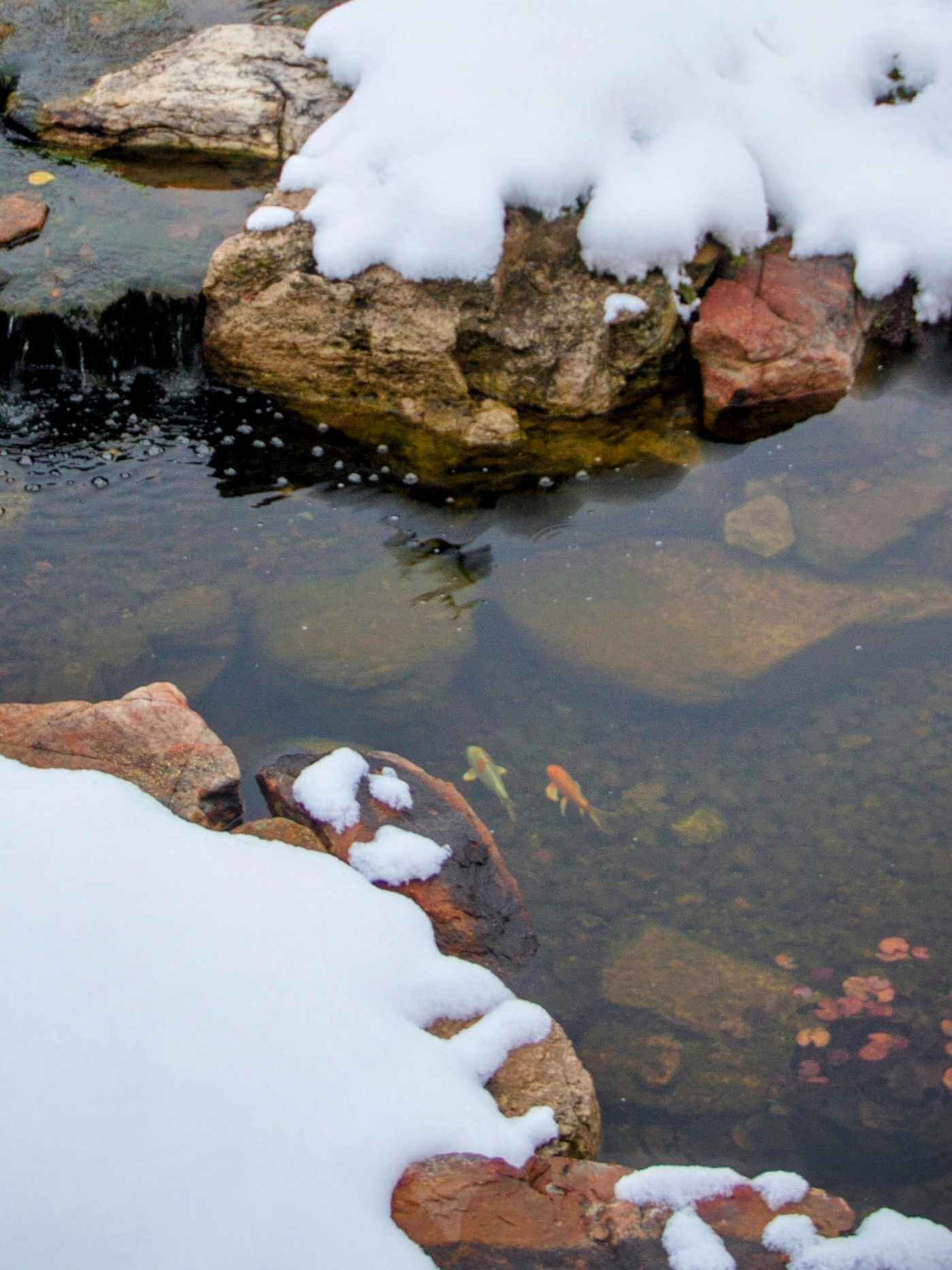Feeding Fish in Minnesota Winter: Why Less is More for Their Health
The first cold snap of the year had just settled over the Twin Cities, and I got a call from a concerned pond owner in Apple Valley. “It’s my first year in a home with a pond so I’ve been feeding my fish all summer, and now the pond is freezing over—should I keep feeding them?” It’s a common question for Minnesota pond owners, especially as we transition from summer water gardens to frost-covered landscapes.
I could hear the genuine concern in Tammy’s voice. It was their first year raising koi, and she had grown so attached to them that she didn’t want to do anything that might harm them. As we talked about her feeding routine, it became clear that their schedule hadn’t adjusted to the changing temperatures. In fact, neither Tammy nor her husband had taken any steps to winterize their pond—they simply didn’t know where to start.
After performing a winterization service and installing a temperature monitoring system that connected to their phones, I walked Tammy and her husband through a safe feeding routine and showed them how to use their new equipment. By the end of our visit, they felt confident about caring for their pond through the winter. Come spring, their koi were thriving, and the pond was clearer and healthier than ever.
Like many of our clients, they wanted to do what was best for their fish, but they weren’t sure how to navigate winter care. Understanding how to care for your pond fish during this season is essential for their health. If you’re worried about your fish going hungry or harming their natural hibernation process, don’t worry. Here’s everything you need to know about feeding fish as the temperatures drop—and why sometimes, the best care is doing less.
Prefer to listen instead? Listen to Andrew and Emma of the Ponderings Podcast discuss this article below!

Why Feeding Changes with Cold Weather
As the water temperature drops, so does your fish’s metabolism. Fish like koi and goldfish are poikilothermic (cold-blooded animals), meaning their body temperature (and metabolic rate) matches their surroundings. In cold water, their digestion slows significantly, and they enter a state of dormancy known as torpor.
Continuing to feed your fish during this time can cause uneaten food to linger in the pond, leading to water quality issues and excess waste. Worse, any food they do consume might not fully digest, leading to internal health problems as the food rots in their stomachs. A well-monitored feeding schedule is the best way to support your fish’s natural hibernation and be sure they emerge healthy in the spring.
Steps for Healthy Feeding as Temperatures Drop
1. Monitor Your Pond’s Water Temperature
Investing in a submersible pond thermometer is a small but important step for any pond owner. The University of Minnesota explains that “monitoring water temperature is crucial as Minnesota’s winters can be harsh. A simple thermometer can guide feeding schedules and help maintain a balanced pond ecosystem” (Cold Weather Pond Management). Regularly check your water thermometer (or invest in a digital thermometer which syncs with your phone) starting in early fall to determine when to adjust your feeding routine Here’s the recommended feeding plan:
- 60°F and Above: Feed your fish their usual high-protein summer diet.
- 50–60°F: Switch to a low-protein, high-carbohydrate diet, like wheat germ-based food. Begin reducing feeding frequency to every 2–3 days.
- Below 50°F: Stop feeding entirely.
Fish rely on their stored body fat to sustain them during torpor, so you don’t need to worry about starvation. It’s how so many animals survive the winter in Minnesota until Spring
2. Transition to a Low-Protein Diet in Fall
As temperatures dip to 60°F, begin transitioning your fish to a fall diet that mimics the seasonal changes in their natural environment. A low-protein, high-carbohydrate food like wheat germ provides easily digestible energy while preparing their systems for winter dormancy. Additionally, if you’re an everyday-fish-feeder, reduce feedings to every few days.
This gradual transition not only prevents digestive stress but also ensures your fish have the energy reserves they need for a healthy winter (National Association of Landscape Professionals, Seasonal Water Feature Care). And healthy fish are happy fish!
3. Stop Feeding Below 50°F
Once your pond’s water consistently stays below 50°F, it’s time to stop feeding entirely. Feeding during this period can disrupt your fish’s natural dormancy cycle and create waste that both degrades water quality over winter and can cause some serious stomach rot in your fish.
Trust your fish’s biology—they are remarkably resilient and adapted to surviving off stored energy during the cold months. They were made this way and are perfectly happy sleeping the winter away.
Why This Matters for You
Helping your fish prepare for winter isn’t just about their health—it’s about maintaining the balance and beauty of your ponds ecosystem. By monitoring water temperatures, adjusting diets in fall, and stopping their feeding before winter, you’re giving your fish the best chance to thrive when spring returns.
How will you prepare your pond and fish friends for the coming winter? Whether you’re ready to tackle this yourself or need professional guidance, we’d love to hear from you. Let’s keep your pond—and your fish—healthy, happy, and ready for the next season of Minnesota’s natural winter beauty!
How Superior Ponds Can Help
If you’re unsure about the right timing or approach to winter fish care, we’re here to help. At Superior Ponds, we use advanced care equipment and provide seasonal maintenance membership services to ensure your pond and fish are set up for success. Our experience with many water feature owners around Minneapolis, St. Paul, and southern Minnesota allows us to tailor solutions to fit specific needs. Whether it’s helping you transition your pond into winter or answering your fish care questions, we’re with you every step of the way. Contact us today and let us know how we can help!
